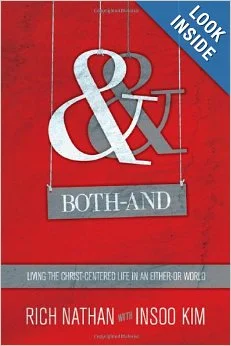Why "Both And" May Be the Most Important Book You'll Read This Year
by Rick Love
I remember the first time I heard Rich Nathan speak on being a “Both-And” Christian. My heart was burning within me. I felt like the disciples did when Jesus walked them through the Old Testament after his death (Luke 24:13-35).
Why was I so stirred?
Because Rich was offering a paradigm, a way of looking at the Scripture, that was serious about the whole Bible. Here was a wide-angle lens into the Bible that would not allow anyone to cherry pick their favorite verses and ignore others. Here was the knock-out punch to sound bite theology.
Let me give you a personal example of the downside of sound bite theology. When I speak on peacemaking there is always someone who raises their hand and asks, “what about the verse where Jesus says, 'I did not come to bring peace but a sword'?" (Matthew 10:34). Unfortunately, for many this is the dominant perspective regarding peace and witness in the New Testament. Why is this harmful?
This one-sided perspective assumes that conflict will prevail, so peacemaking is futile.
This either-or approach to Scripture negates the many verses on peace in the Bible and keeps followers of Jesus from obeying the clear teaching in Scripture about peacemaking, and this leads to many disobedient disciples!
However, a both-and perspective acknowledges that division will be one result of sharing the gospel, but it also takes the Bible’s teaching about peacemaking seriously (see for example Matthew 5:9; 10:13; Luke 2:14; 10:5-6; Luke 19:42; Romans 12:18; Hebrews 12:14).
In an increasingly polarized and uncivil world, Both-And: Living the Christ-Centered Life in an Either-Or World by Rich Nathan and Insoo Kim is a breath of fresh air. No, actually it's a hurricane of robust theology, pastoral wisdom, and prophetic insight.
Here are just three quotes to give you a feel for the book’s prophetic thesis:
”From beginning to end, the Bible is a Both-And book. The God of the Bible is portrayed as the God of both creation and covenant. He cares about all the nations and He enters into a special relationship with His people. He is God over both the secular and the sacred, both the material realm and the spiritual realm” (pg.17).
"To be a disciple of Jesus is to live in tension. We worship one God who exists in three persons. We serve Jesus who is both fully God and fully man. We live in a world that is both good and fallen. And the kingdom of God that Jesus announced is both already here and is still to come. This tension exists not only in what we believe and experience but in who we are: both sinner and saint” (pg. 21).
“We must embrace the fact that we are called to be Both-And Christians, to serve a Both-And God, and to preach a Both-And gospel" (p 22).
The book is structured around seven questions, along with the clearly articulated “both-and” response:
What is our identity? Evangelical and Charismatic
What is our community? Unity and Diversity
What is our concern? Mercy and Justice
What is our method? Proclamation and Demonstration
What is our ethic? Personal and Social
What is our expectation? Already and Not Yet
What is our calling? Relevant Practice and Orthodox Doctrine
This book has special relevance for peacemakers (so I am personally giving a copy to my staff in Peace Catalyst International). First, there is a whole section on peacemaking (pp. 54-68). Second, the strong emphasis on a holistic gospel strengthens evangelicals committed to both working for peace and sharing the gospel of peace. Finally, the book boldly addresses some of the unique challenges against peace, such as the military industrial complex:
"Few Christians in America consider it strange that the United States, with less than 5 percent of the world's population, has a military budget equal to that of the entire rest of the world combined. Few Christians in America consider it strange that the United States has been in an almost continuous war somewhere in the world for the past fifty years, or that, as a nation that celebrates our essential goodness, we are by far the world's largest arms exporter" (pg. 206-207).
In a book about “Both-And” thinking you will also find sections and issues that challenge you personally, which is to be expected in a book like this. There were a few sections where I said to myself, “good point! I need to work on that, I need to grow in that area.”
But the greatness of the book is its over-arching framework. You don’t have to agree with every topic addressed or every argument set forth to be profoundly challenged and enriched. The Both-And paradigm is revolutionary because it helps us understand and obey all of Scripture, something Moses, Jesus, and Paul were deeply concerned about: “All Scripture is God-breathed and is useful for teaching, rebuking, correcting, and training in righteousness (2 Timothy 3:16; see also Deuteronomy 8:3; Matthew 4:4; Luke 24:25-27; Acts 20:27).
Both-And: Living the Christ-Centered Life in an Either-Or World could be the most important book you read in 2013!











